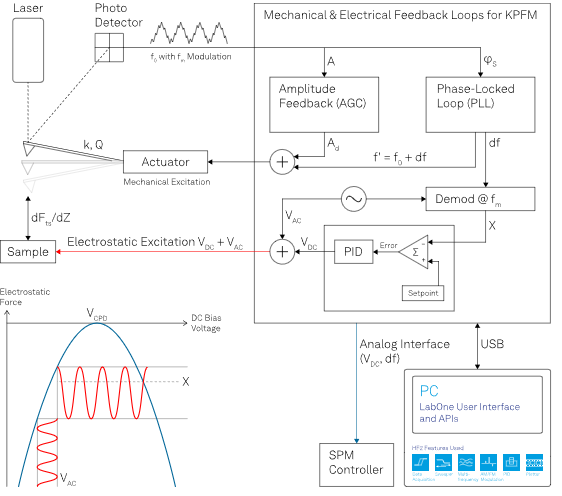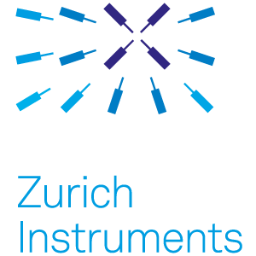Application Description
Kelvin probe force microscopy (abbreviated as KPFM, KFM or SKFM) is a technique predicated on atomic force microscopy (AFM): used to examine the electronic properties of nanoscale materials and devices.
KPFM quantifies the local contact potential difference (CPD) between a sample surface and an AFM probe by exposing a capacitive electrostatic force.
Where metal surfaces are concerned, the KPFM signal is related to the work function of the material directly, while the relation for semiconductor CPD will be toward the doping profiles of semiconductors or surface photo-voltage (SPV) of photo-sensitive thin films.
The majority of KPFM methods detailed on this page are known as closed-loop single pass techniques, where active tracking and imaging of the local CPD is conducted in parallel to the surface topography or other force contributions.
Open-loop variants of KPFM are considered to be an extension to electrostatic force microscopy (EFM), where a sinusoidal electric modulation brings about three spectral components: a static DC term and two AC components at the primary and secondary harmonic of the bias modulation frequency.
When active tracking of the CPD is not being performed by a feedback loop, its value can be calculated from the 2 AC components in the dual-harmonic (DH-KPFM) mode; this is especially useful for measurements recorded in liquids.
Measurement Strategies
In a conventional KPFM setup, the application of a probing AC bias voltage overlaid onto a DC voltage produces an electrostatic force between the tip and sample that can be recorded with a standard lock-in detection technique (see figure).

Figure 1. Typical FM-KPFM measurement scheme where the mechanical resonance signal is demodulated at the electrical bias modulation frequency. All KPFM modes require an electrical drive at VAC+VDC while the bias feedback only acts on VDC and is recorded to map the surface potential. By sweeping the DC bias voltage, it is possible to reconstruct the CPD parabola. The VAC modulation is used to find the maximum of the parabola by minimizing the X component of the resulting force modulation measured with a lock-in amplifier or a PLL. Image Credit: Zurich Instruments
Subject to the measurement scheme (see table), the appropriate demodulated component of the force or the force gradient is passed through a PID loop, which in turn manipulates the DC bias voltage to limit the electrostatic force.
When the electrostatic contribution is negated by the applied DC source, the CPD value of interest has been achieved.
Numerous existing KPFM modes can be placed into one of two categories, specifically amplitude-modulated KPFM (AM-KPFM) and frequency-modulated KPFM (FM-KPFM).
AM-KPFM modes are sturdy and simple to apply, but their resolution is inhibited by the large stray capacitance from the cone and cantilever geometry. AM-KPFM can be helpful for large and rapid surface inspection and can usually function with smaller AC drive voltage.
Due to its force gradient sensitivity, FM-KPFM modes unlock ultimate surface potential resolution, but they are not so straightforward when it comes to optimization and operation in stable conditions across rough surfaces.
Recent technical progress in heterodyne FM-KPFM in air and in 2ω dissipation KPFM (2ωD-KPFM) in vacuum has come to characterize advanced methods in terms of quantitative measurements as these modes are less prone to artefacts.
In contrast to more conventional dual-pass techniques – one pass for the topography, one pass for the electrostatic contribution – single-pass measurements limit bias artifacts in the topography, enhance the surface potential resolution, and shorten measurement times.
As many parameters of single-pass KPFM techniques demand acute adjustments, the Zurich Instruments LabOne® control software safeguards the entire optimization process, making it more systematic and consistent.
This is a result of setting several demodulators at various harmonics or frequencies, phase shifters, as well as multiple feedback loops and parametric sweeper functionality.
The Benefits of Choosing Zurich Instruments
- With a single instrument, any closed-loop or open-loop KPFM mode can be measured by reloading the settings to switch between modes.
- The best parameter set for rapidly maximizing the signal-to-noise ratio is made possible thanks to a high0level of automation that enables the sweeping of key parameters, including phase shifter and frequency mixer.
- The PID advisor enables optimization of the bias feedback loop without prior knowledge or manual tweaking of gain parameters.
- Zurich instruments adapt to any kind of third-party microscope provided there is access to electrical actuation and detection.

This information has been sourced, reviewed and adapted from materials provided by Zurich Instruments.
For more information on this source, please visit Zurich Instruments.